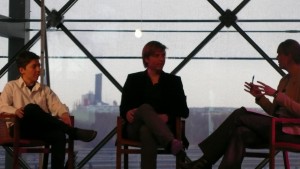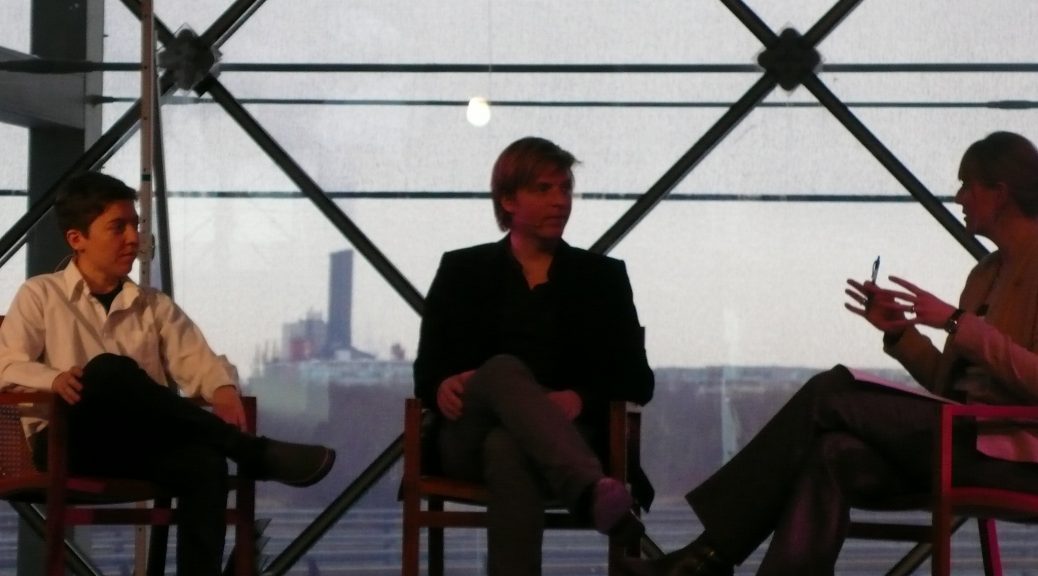The 2nd Sharing is Caring seminar was held 12 December 2012. The seminar focused on real life practical examples of the impact of sharing digitized collections, and the authority to use them.
“At the first Sharing is Caring in 2011, we set the agenda for why it is important that cultural heritage institutions open up their digitized assets to the public, and how it can be done. This year, let’s get real: Let’s learn from concrete cases at institutions who have taken radical steps to open up and collaborate with the public. What are the challenges when opening up and engaging with the public – not only traditional cultural heritage lovers, but also people we don’t normally reach: Non-users and users who might not fit into a Eurocentric definition of culture. What can we learn if we open up to authentic two-way dialogue that might demand us to change?
What are the hard facts behind the philanthropic vision of opening up? How do vision and reality interact? What do the actual usage, statistics, and data tell? What are the keys to success, and what are the biggest barriers that we must face when engaging with users and letting go of control over our assets.”

Photos from Sharing is Caring 2012
Video archive of talks and debates at Sharing is Caring
Program
9.30: Coffee
10.00: Welcome by organizers Hans Henrik Appel, ODM and Merete Sanderhoff, SMK
10.15: Keynote #1: Shelley Bernstein, Chief of Technology, Brooklyn Museum
“New Methods to Foster Deep Engagement”
Shelley will talk about the Brooklyn Museum’s mission as a departure point for recent initiatives, including GO, a project where Brooklyn-based artists were asked to open their studios to the community, so visitors could nominate artists for inclusion in a group exhibition at the Museum. GO will be discussed in the context of other in-gallery and online projects that have been developed in recent years to explore alternative methods with the aim to engage museum audiences in deep ways.
11.00: Keynote #2: Jasper Visser, digital strategist, Inspired by Coffee
“The future of museums is about attitude (not technology)”
To say the digital revolution has changed the world is like opening a novel on a dark andstormy night, to paraphrase global strategist Pankaj Ghemawat. Yet it has. Audiences change, their expectations change, funding changes… Museums will have to adapt to this new reality and reinvent their role in society to remain relevant in years to come. However,this has more to do with dramatically changing their attitude than with an increased focus on the use of technology. In this high-paced presentation digital strategist Jasper Visser will summarize good practices for museums to remain relevant in the 21st century, drawing from his international experience as a consultant for cultural institutions. The presentation will present actionable lessons the audience can take home and apply in their institution.
11.45: Short break
12.00: Keynotes in conversation – Shelley Bernstein and Jasper Visser, moderated by Merete Sanderhoff
12.45: Lunch
13.30: Ignite session – one hour of inspiring cases, insights and discussions
Ellen Pettersson, Communicator of Digital Engagement, digidel.se: ”Digital literacy is a prerequisite for digital learning”
The Digidel 2013 campaign is for organizations, companies and authorities who work together with private citizens in raising the question of digital inclusion. Digidel’s aim is for everybody to have the knowledge, courage and understanding needed to use the Internet in everyday life. Using the Internet is a question of democracy when your life, services and companies go digital.
Lise Sattrup, Ph.D. fellow, RUC, & Nana Bernhardt, Head of Education and Development, SMK:
“Museums and cultural institutions as spaces for Cultural Citizenship”
Ten Danish museums and cultural institutions collaborate to examine how to create spaces for Cultural Citizenship. This has raised lots of questions, the most significant perhaps being how knowledge is produced. The project is based on Mikhail Bakhtin’s term ‘Multivoicedness’. We will give a few examples of how the involved museums invite users to participate and let their voices become part of the production of knowledge through co-creation, thus unfolding a potential for mutual learning processes both for users and museums.
Lene Krogh Jeppesen, Innovator & Knowledgesharer, Danish Ministry of Taxation: “@skattefar – using Twitter to communicate with citizens”
In this world nothing can be said to be certain, except death and taxes”, Benjamin Franklin said, thus voicing a common attitude towards taxes: boring, dreaded and quite dusty. Add to that a modern bureaucracy and the image of an authority as a big black box, lots of red tape and complicated rules is complete. The Danish Ministry of Taxation uses Twitter (@skattefar) to illuminate the big black box and to give taxes a more humane yet professional voice. @skattefar is part of a bigger movement changing the authority’s perception of citizens as well as citizens’ perception of the authority. An honest insight into what happens when a modern bureaucracy ventures on new paths.
Nanna Holdgaard, Ph.D. fellow, ITU & Bjarki Valtysson, Associate Professor, KU:
“Caring for whom? – Perspectives on participation in social media”
In this talk we will discuss the participatory potentials of social media, particularly Facebook, and inspect how its affordances stage participation, sharing, and the act of creating. Political parties, politicians, businesses, cultural institutions, media institutions, artists, producers, consumers, and users – you name it – everyone is online. But how can these kinds of communications best be described and what should cultural institutions financed by the state be aware of? Is it marketization? Is it empowerment? Is it communication for the sake of communication? Is it caring – and if this is the case, caring for whom?
Ditte Laursen, Ph. D. and Media Researcher, The State and University Library, Aarhus:
“Meeting the visitor: Distribution and dissemination of mobile guides at the museum front desk”
Over the years, the benefits of mobile devices in museums have been explored in a number of papers. Yet studies show that encouraging visitors to use mobile interpretation is the largest challenge in implementing mobile projects in museums. One of the keys to encouraging visitors to use mobile interpretation – one that has received little attention so far – is the distribution and dissemination of the guides. This presentation focuses on the operation of the museum’s front desk. Based on video recordings, it addresses the interaction between front desk assistants and visitors, highlighting barriers and organizational challenges in the distribution and dissemination of multimedia guides.
Peter Leth, Educational Advisor, Lær-IT & Creative Commons Danmark:
“Open licensing opens up education”
If teachers violate copyright law in our educational practices we criminalize both ourselves and our students. Any use of other peoples’ knowledge in an IT-didactical context requires that we are allowed to use this knowledge. Consequently, the school system must ensure that students are offered a basic understanding of copyright law along with a range of tools to search for materials they are allowed to use. Creative Commons licenses make the communication between owner and user short, clear, concise, and user-friendly. They establish the foundation for a legal and rich environment for learning. At Lær IT we have developed a toolset called SchoolTube that ensures a safe learning environment providing students access to both knowledge and tools to reach their learning goals.
Miriam Lerkenfeld, Project Manager, The Danish Broadcasting Corporation:
“Old Content in a New Domain – Giving Access to Cultural Heritage”
DR has launched the laboratory Dansk Kulturarv by opening the radio- and TV-archive to the Danish citizens. The goal of Dansk Kulturarv is to create access to as much data as possible, for as many Danes as possible – but there are numerous limits. The limits are often related to platforms, technology, copyright and communities controlled by commercial interests. This makes it hard to expose public service content outside the traditional domains. This session will present some of the problems that arise when a public broadcaster wishes to share content on the Internet. It will also give some insights to how hard it is for a cultural institution to share content and combine it with content from other cultural institutions. But in the end also, how one should focus on collaborating and keeping the users engaged.
Theis Vallø Madsen, PhD Fellow, Aarhus University and KUNSTEN Museum of Modern Art:
“Mapping the Messy Archive”
In the sixties a group of American avant-garde artists began experimenting with fluctuating, intertwining information. They built a decentralized, rhizomatic network where art and information circulated between artists outside the official institutions of art. The mail art network was an offspring of the Fluxus movement and was based on the same principles as we see in today’s digital culture: There is no autonomous work of art within the mail art network because every piece is part of an exchange between a sender and one or more receivers. In cooperation with three museums, Meaning Making Experience, Danish Broadcasting Corporation and a group of digital developers, I am working on the development of a digital map of a mail art archive, i.e. Danish artist Mogens Otto Nielsen’s archive at KUNSTEN Museum of Modern Art. This collaboration – “The Mapping Project” – sets out to develop new ways of visualizing messy, entangled museum collections.
14.30: Coffee break
15.00: Jill Cousins, Executive Director of the Europeana Foundation
“Building a European Cultural Commons”
European Memory institutions have been the custodians of our culture for many a year. They preserve, conserve, and now digitise our past. Creating access to this huge repository means creating some common ground where both providers and users can play and gain new partnerships and new innovations. Europeana has been facilitating workshops for just over a year aimed at developing a European Cultural Commons, where caring is sharing and the world is possibly a richer place.
15.30: Sarah Giersing, Curator, Museum of Copenhagen
“The WALL in Copenhagen and Cairo. When citizens create their city’s history”
Sharing is not only about creating access to museum collections. It is about sharing the authority to interpret and augment these. Although many museums have embraced participatory information sharing, few have yet let it affect their information accumulating activities of cataloguing and collecting. The WALL in Copenhagen suggests new ways to let audiences explore and discuss their city’s history as well as shape and document digital future heritage. This presentation explores how this concept is unfolding in Copenhagen – and in the very different cultural and political climate of Cairo, where an adaptaion of the WALL is currently underway.
16.00: Jacob Wang, Head of Digital Media, The National Museum of Denmark
“The Digital Museum as Platform”
The National Museum needs a digital revolution and the hard work has begun! But what does it look like when a “digital museum” is built – not from the ground up, but from the messy place known as “now”? Who are the participants in such an effort, what is needed from them and how will they (we) be changed in the process? Museums are organizations in the “forever-business”, so how do we plan our activities for them to be both relevant today and valuable in the far future?
In my talk, I will share some of the core challenges the National Museum is facing (primarily as a digital museum) and suggest ideas and principles with which to tackle them: government 2.0, lean startup methodologies, hacker-mentality, in-house digital hacktivism, crowd-sourcing and community-engagement, the ‘self-conscious-generous-meta-museum’ and other more or less homegrown strategies “to do work that matters”.
16.30: Panel discussion
16.45: Concluding remarks by Merete Sanderhoff, SMK
17.00: End of seminar
